Lightning strikes and cruising yacht
What is lightning?
In essence, lightning is an unexpected extremely high-voltage flow of electricity that can transpire in 3 ways:
- within a cloud,
- between clouds, or
- between a cloud and the ground.
The first 2 points will give us some spectacular fireworks in the sky but do not directly concern us as sailors. The latter, however, could cause us some grief. This “cloud to ground” strike is also known as a “ground flash”.
Where warm air meets cold air, the warm air will have a tendency to rise and consequently pulls down the cold air into the vacuum it just created. This updraft and downdraft cause the need for positively charged electrons to find an equilibrium with the negatively charged electrons. This natural balance is achieved through lightning.
Although meteorologists are not to bad at forecasting thunder stormes, science has not yet been able to predict lightning. So the best strategy to avoid lightning strikes is to recognise where they form and avoid the area…
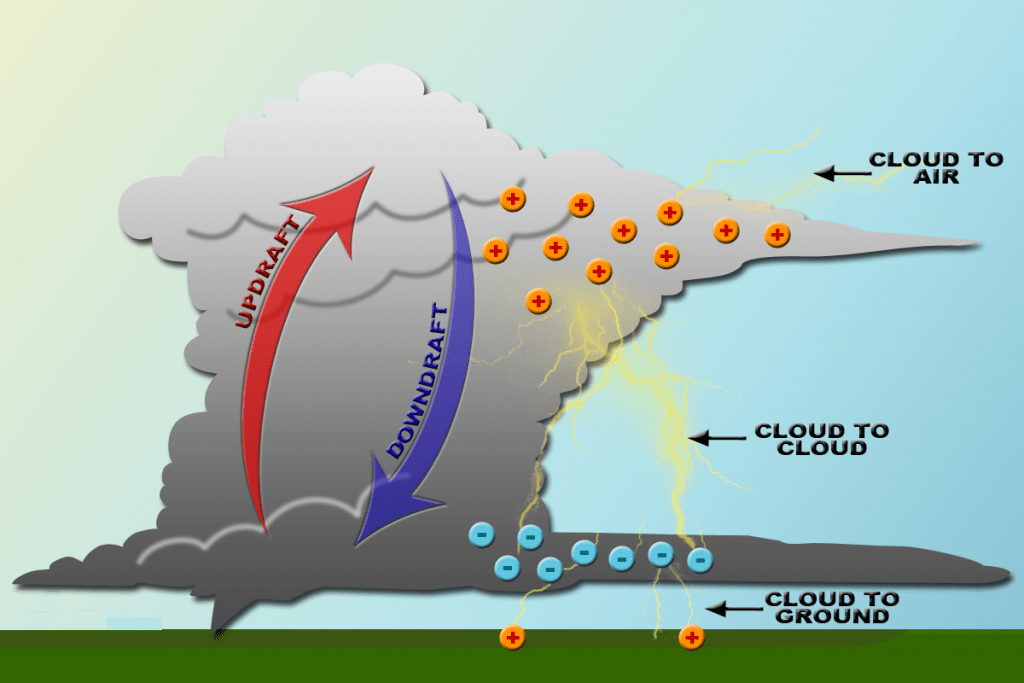
Spotting potential lightning
Cumulonimbus clouds are an easy way to spot potential thunderstorms and lightning. Cumulonimbus clouds are very dense and often have a vertically rising “column” of water vapours caused by an updraft. They not only are potential lightning clouds but more often than not, carry huge amounts of potential precipitation which usually means rain but can include hail as well.
So the cheapest, easiest and most effective mitigation strategy is to avoid lightning…

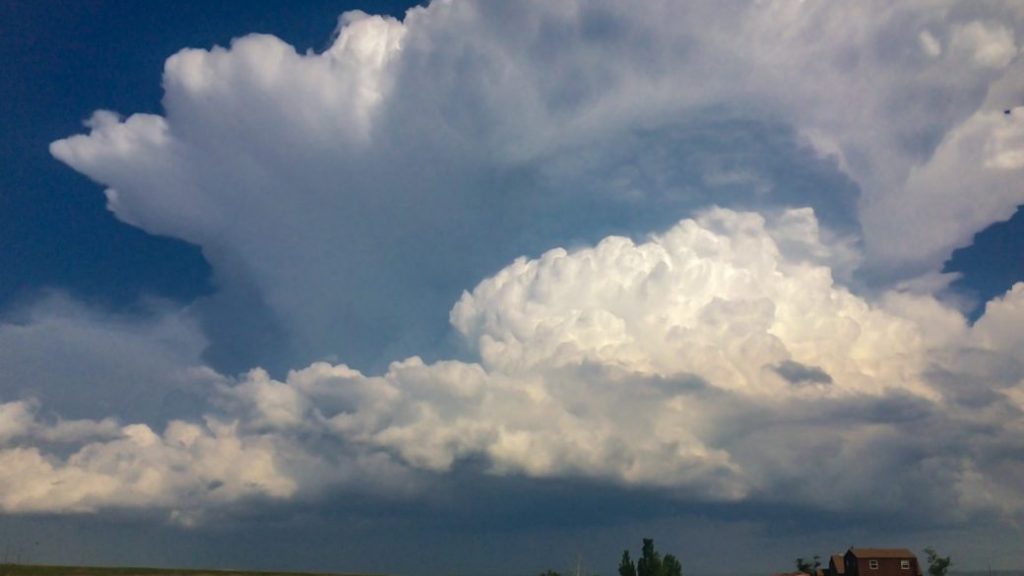
Some common lightning myths...
- Let’s start with the most used myth of all. Lightning never strikes twice. Absolutely not true. The Empire State Building is on average struck by lightning more than 20 times per year. Perhaps you think the myth relates more to people not getting struck twice? If so, then think of Roy Sullivan, US park ranger in Virginia. He was hit by lightning seven times and survived all of them.
- Another myth is that lightning only strikes the tallest object around. As a sailor, you may be somewhat relieved that lightning is indiscriminate and it can strike anywhere. It can hit a park bench 5 meters away from a telegraph pole. It can hit a newspaper stand next to a skyscraper… Saying this, height and isolation are the dominant factors in whether lightning will strike an object. The point is, don’t rely on this. It doesn’t mean you are safe if the yacht next to you is 10 meters taller…
- Don’t touch a lightning victim or you will be electrocuted. Well, no… There is no way a human can hold electrical charge large enough to present a danger to others. So apply first aid immediately following the DRSABCD system.
- It is not raining so we are safe… Not necessarily. Lightning could strike more than 4 kilometres from a visible thunderstorm. Perhaps the idiom “a bolt from the blue” says it all…
- The last myth is something we can be happy about which is the myth that a yacht with a mast is more dangerous. The fact is, that most lightning-related boating deaths occur on small open motorboats.
The ground flash touchdown
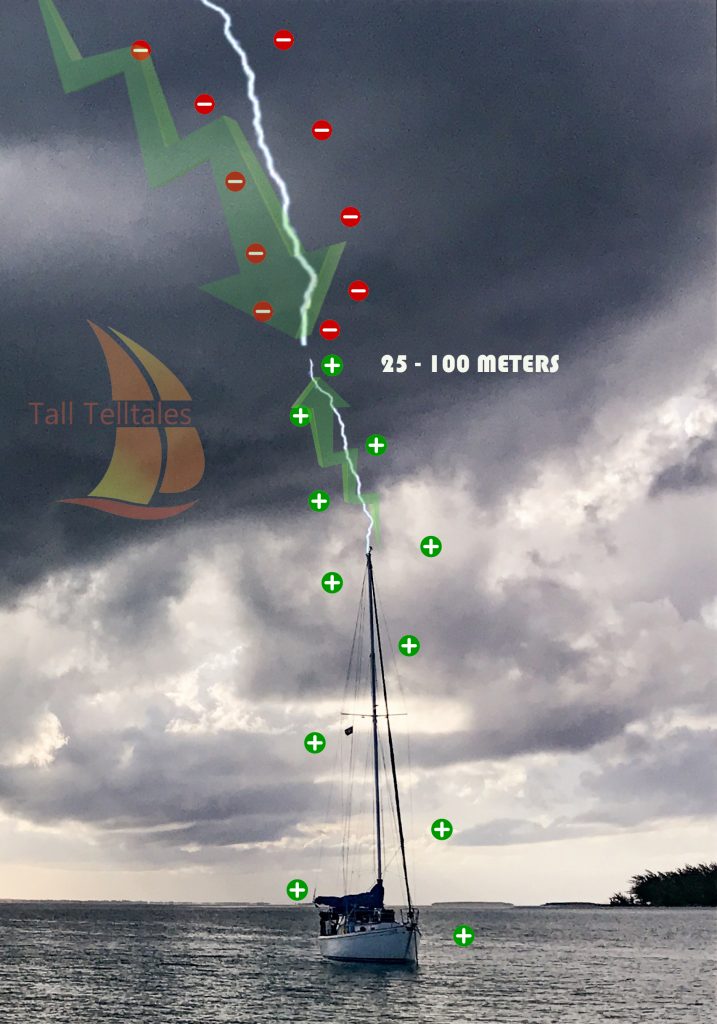
It is generally believed that a lightning strike comes from the cloud and finds its path all the way to the ground.
This is true to a certain extent but in fact, the ground will “meet” this ground flash up in the air.
The negative electrons from the cloud will attract positive electrons on the ground well before impact. The actual “shortcircuit” is completed some 25 to 100 meter up in the air.
Ignorance is bliss…

A hair raising moment… A lightning strike is ominously imminent. At least they seem happy and it would make a lovely picture on the mantelpiece for the surviving family…
Hot spots to avoid
Okay, let’s start with the worst of the worst: Lake Maracaibo in Venezuela.
You can expect lightning on 297 days of the year producing over 230 lightning flashes per square kilometre each year.
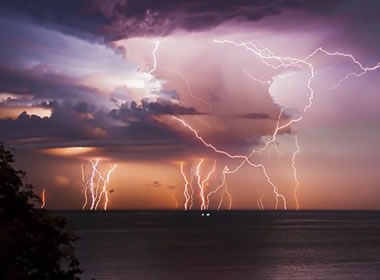
To keep this in context it may not be fruitful to dwell on areas where lightning is more prevalent than others. Our friends at NASA monitor lightning strikes and you will get a general idea of where you may expect lightning to occur more frequently from the map below and hence to avoid or better prepare your boat if avoiding is not a practicable solution…

Lightning detection units
With our reliance on electronics to start our engine, navigate from A to B, control our helm and communicate, there is a real need to rethink what this means in terms of our vulnerability to lightning strikes. Prevention is better than cure as they say. So being aware of potential lightning strikes has to be a good thing.
Let’s have a look at some of the gadgets that may assist in keeping out of trouble by detecting lightning storms early… I have not tested these devices personally but asked the manufacturer to send us one so we can do an independent review on them. Subscribe to our newsletter if you would like to be notified of the results…
LD3000 STRIKEALERT
StrikeAlert HD proclaims to be the first personal lightning detector with a graphical display that shows you the lightning strike distance (from 0 – 40 miles away) as well as a 1-hour storm trend and intensity.
More to follow on this after we conducted the review…
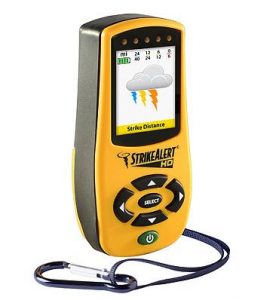
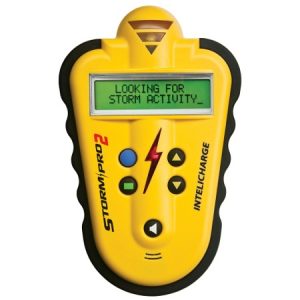
Storm Pro 2
The completely re-designed Storm Pro2 storm tracking and lightning detector system uses advanced charging circuitry to eliminate the need for costly battery purchases.
The new Intelicharge technology allows the use and charging of the Storm Pro2 anywhere in the world.
More to follow on this after we conducted the review…
SkyScan P5-3
The SkyScan Model P5-3 lightning detector is the newest high technology weather monitoring product available anywhere in the world. It is a hand-held instrument with an electronic system to detect the presence of lightning / thunderstorm activity occurring within 40 miles of your location.
More to follow on this after we conducted the review…
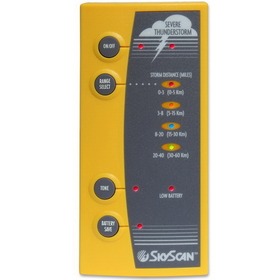
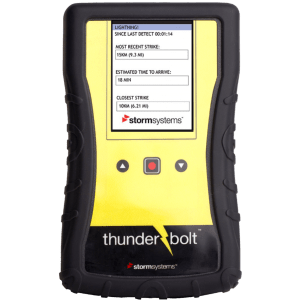
Thunderbolt X2
- Easy to use
- Greater detection speed & accuracy
- Detects both cloud-to-ground and intra-cloud activity
Larger Color LCD display gives up-to-date information on storm status. - FCC / RoHS / CE Certified
- Much more…
More to follow on this after we conducted the review…
30/30 rule and judging distance
There is a rule of thumb that says that if you see lightning in the sky, you should be able to count to 30 before you hear the rumble. If not, you need to seek shelter inside. Then only leave the shelter 30 minutes after the last thunderclap.
You can judge the distance of lightning by using a simple equation. Ie, count the seconds between a lightning flash and the thunder that follows. Divide those seconds by 5 and you will roughly get the distance in nautical miles. For example, if you see a flash and can count 20 seconds before you hear the thunderclap it means that the lightning is 4 nm away. (20 ÷ 5 = 4)
Preparing your yacht for lightning strikes
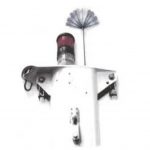
In the context of lightning mitigation, there are two types of yachts. Those that have a grounding system and those that do not.
With a grounded system, your yacht has a lightning arrester to focus the strike’s point of impact. The power is then conducted into the water via adequately sized cables in an attempt to carry the electricity through a path of least resistance towards the water. This path should be the shortest, most direct route possible. This is often installed at the manufacturing stage but can be fitted retrospectively.
Invented by Benjamin Franklin in 1752, the lightning rod plays an important part in our lightning mitigation strategy. It acts as the focal point for lightning to strike. There is no guarantee it will, but the law of probability says that the strike will seek a high point which is geographically isolated. For most of us, the lightning rod is our mast.
We then need to “persuade” this strike to follow a path in order for the electrical charge to exit our vessel in a controlled manner. We can use grounding plates for this but in most cases, this will be our keel.
We do not really want to play with this bully but since we have no choice, we may as well set some “ground rules” (no pun intended)…
Lightning storm preperation
Sometimes it is not possible to avoid a thunderstorm and the probability of a lightning strike is now not imminent but certainly possible. What do you do to prepare your boat and yourself to minimise the effect of a potential lightning strike?
1 – When you think you are in danger of a potential lightning strike, take note of where you are. Getting out your paper chart at this point in time is just common sense because navigational equipment failure if a real risk. If you know where you are on a paper chart, you have a handy head-start in navigating to a safe port. Concurrently, you may want to ensure that you have a redundancy system so when your main plotter shows you a black screen you have your mobile phone ready to take over.
You can store handheld devices in your oven as it may work as a Faraday cage in protecting your equipment.
2 – Disconnect anything from the power which you consider not essential. Disconnect (or at least lower) antennas if practicable. Most of the time, your damage will be to your electrical equipment so disconnecting your gadgets will go a long way in preserving them.
3 – The best place to be on your yacht is inside your cabin. Move to an area where there are minimal metal objects and away from your mast, keel or chain-plates.
4 – If you have to be in the open, stay away from metal including stays, helms or any other metal deck ware such as railings. Metal is your enemy as well as your friend. When set up well, it will conduct the charge away from your boat and into the water. But all other metals on your boat have the tendency to bite you. Metal includes jewellery such as (ear)rings and necklaces, watches and any piercing studs you may have. Wear gloves if you need to touch metal!
5 – Don’t use the radio or any other communication devices unless absolutely necessary. They have a tendency to go “boom” if hit by lightning.
6 – Do not go in the water either directly or indirectly using fishing lines etc. Do not give the charge an alternative route out of your boat particularly if you make yourself part of that path.
7 – Although there are two schools of thought about this, turn your engine on. You may not be in a position to restart it depending on your setup. A sophisticated engine heavily relies on electronics if not just a starter battery and motor: both are prone to be damaged by a lightning strike…
8 – Make sure you are able to deal with the consequences that may pop up. A thru-hull fitting may blow out leaving a hole in your boat under the waterline. Get you multi-sized wooden bungs ready or at least remind yourself where they are stored. Make sure your manual bilge is in working order. Start looking for your underwater repair epoxy putty. Get a tarp ready…
9 – When you do get hit by a lightning strike check on your crew first. Look in your bilge to see if it is dry or gathering water from a potentially blown out thru-hull fitting. Make sure your instruments are still working and engage secondary systems where necessary.
The dreaded thru-hull blowout
There is a lot of empirical evidence that lightning strikes can cause thru-hull blowouts. This means your brass or stainless steel thru-hall fitting has dislodged itself from any pipes and found its way to Davy Jones’ Locker or simply melted into nothing.
In any case, you will find yourself with a problem that requires an urgent solution: plugging the hole.
Luckily there are some nifty products on the market that could save your boat from sinking. These devices have maximum bang for buck value and no boat should be without them.
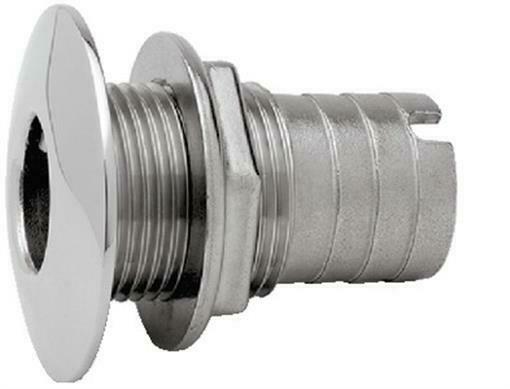
Hull Survivor Emergency Hull Seal
HullSurvivor™ is a flexible but firm, disk-shaped patch designed to conform to the unpredictable shapes of most hull breaches.
- Designed as a circular disk with concentric sealing rings and centre trunion.
- Specifically designed to cover irregular shapes, HullSurvivor™ effectively reduces or eliminates most incoming water flow.
- Whether it is a round hole caused by mechanical failure or an elongated tear due to impact, HullSurvivor™ covers the leak.
We have a few of these coming so we can test them out for you. Subscribe to our newsletter if you would like to be notified of the results…
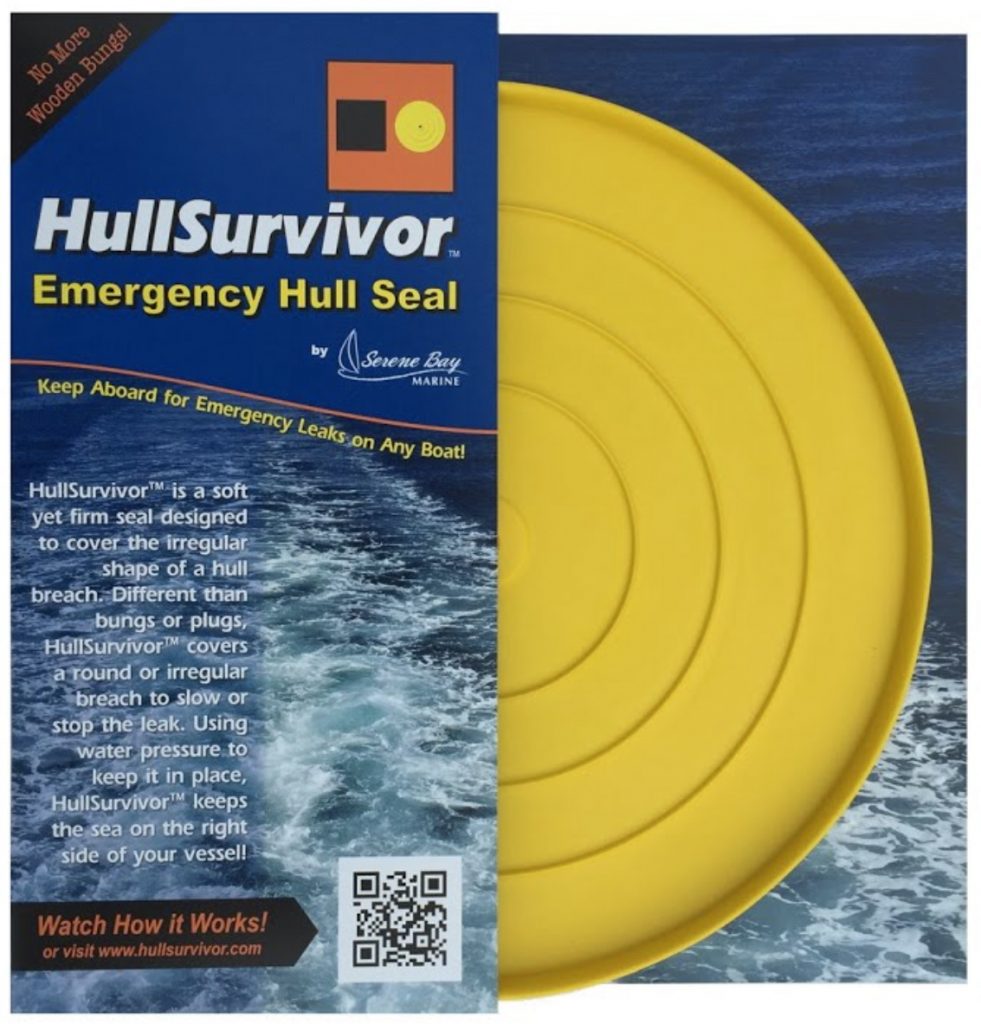

Sta-Plug® Emergency Plug
Sta-Plug® is Forespar’s form-fitting emergency plug. A soft cone-shaped design allows it to easily fill the irregular shapes of hull impact breaches, as well as any round hole leak from a hose or thru-hull. Unique edge gripping riblets help hold the plugin a hole, keeping water out. The riblets help Sta-Plug® conform to the shape of the hole, sealing a leak near the edge where a tight fit is crucial, and holding the plug more securely in place. Different by design, Sta-Plug’s® shape includes a series of concentrically larger riblets stepped along the length of the cone. These riblets offer two big advantages over traditional straight-edged emergency plugs:
- They help Sta-Plug® conform to the hole near the edge where a tight fit is most crucial.
- They help hold it more securely in place.
- Twist and compress by hand to insert into the hole.
- Expands after insertion to hold in place.
We have a few of these coming so we can test them out for you. Subscribe to our newsletter if you would like to be notified of the results…
STAY AFLOAT INSTANT LEAK PLUG AND SEALANT
“Stay afloat”, instant leak plug and sealant, is a simple and versatile material intended to be used in the application of stopping or slowing water leaks. Used alone it requires no mixing, measuring or curing. It is easily moulded and applied by hand; into holes gaps and cracks. Applied in sufficient quantity it can stop or slow many types of leaks. And, combined with other material(s), such as wood or plastics, it can stop or slow larger size leaks.
We have a few of these coming so we can test them out for you. Subscribe to our newsletter if you would like to be notified of the results…

A final word on lightning stikes
Avoidance followed by preparation is the answer to lightning strikes. And when preparing your boat, understand that the forces involved can easily kill a person and sink your yacht. I highly recommend you employ a professional to undertake an assessment of your boat and install the necessary mitigation system. It could save you more than just dollars…
If the article was helpful then don’t be afraid to share it on social media. Also, we love to hear from you so leave a comment below…